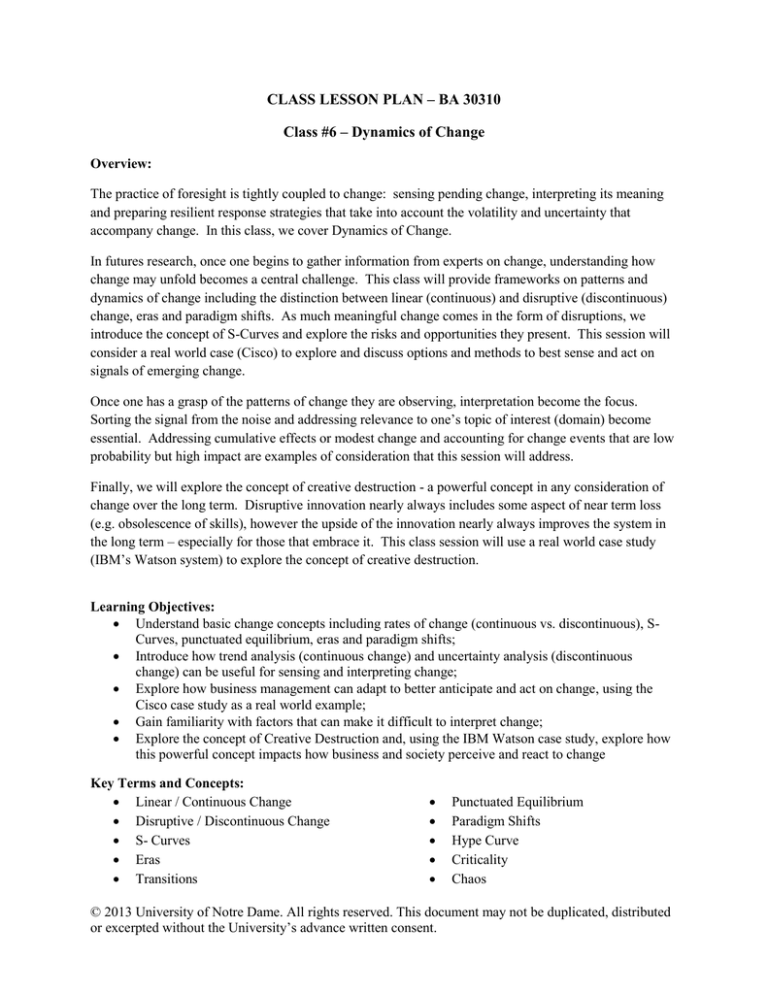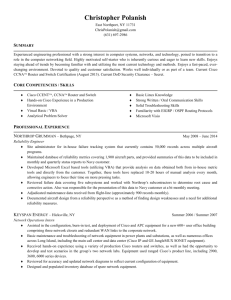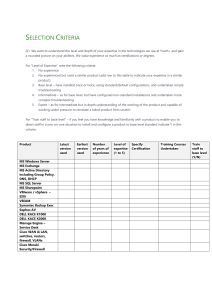
CLASS LESSON PLAN – BA 30310
Class #6 – Dynamics of Change
Overview:
The practice of foresight is tightly coupled to change: sensing pending change, interpreting its meaning
and preparing resilient response strategies that take into account the volatility and uncertainty that
accompany change. In this class, we cover Dynamics of Change.
In futures research, once one begins to gather information from experts on change, understanding how
change may unfold becomes a central challenge. This class will provide frameworks on patterns and
dynamics of change including the distinction between linear (continuous) and disruptive (discontinuous)
change, eras and paradigm shifts. As much meaningful change comes in the form of disruptions, we
introduce the concept of S-Curves and explore the risks and opportunities they present. This session will
consider a real world case (Cisco) to explore and discuss options and methods to best sense and act on
signals of emerging change.
Once one has a grasp of the patterns of change they are observing, interpretation become the focus.
Sorting the signal from the noise and addressing relevance to one’s topic of interest (domain) become
essential. Addressing cumulative effects or modest change and accounting for change events that are low
probability but high impact are examples of consideration that this session will address.
Finally, we will explore the concept of creative destruction - a powerful concept in any consideration of
change over the long term. Disruptive innovation nearly always includes some aspect of near term loss
(e.g. obsolescence of skills), however the upside of the innovation nearly always improves the system in
the long term – especially for those that embrace it. This class session will use a real world case study
(IBM’s Watson system) to explore the concept of creative destruction.
Learning Objectives:
Understand basic change concepts including rates of change (continuous vs. discontinuous), SCurves, punctuated equilibrium, eras and paradigm shifts;
Introduce how trend analysis (continuous change) and uncertainty analysis (discontinuous
change) can be useful for sensing and interpreting change;
Explore how business management can adapt to better anticipate and act on change, using the
Cisco case study as a real world example;
Gain familiarity with factors that can make it difficult to interpret change;
Explore the concept of Creative Destruction and, using the IBM Watson case study, explore how
this powerful concept impacts how business and society perceive and react to change
Key Terms and Concepts:
Linear / Continuous Change
Disruptive / Discontinuous Change
S- Curves
Eras
Transitions
Punctuated Equilibrium
Paradigm Shifts
Hype Curve
Criticality
Chaos
© 2013 University of Notre Dame. All rights reserved. This document may not be duplicated, distributed
or excerpted without the University’s advance written consent.
Wildcards / Black Swans
Unexpected Consequences
Creative Destruction
Market Transitions
Collaborative Management
Class Preparation:
Readings:
“Cisco Sees the Future, - An Interview with John Chambers” (HBR)
“IBM Watson Case Study”
Discussion Questions:
According to John Chamber of Cisco, what is a market transition and how do they differ from
market disruptions? What did Cisco do to take advantage of market transitions and
successfully jump to new s-curves? Provide examples from the reading.
Who’s in charge at Cisco? Describe the organizational structure and management style of
Cisco. Will this type of management structure gain mainstream acceptance? Why or why
not?
The interview with Cisco’s John Chambers occurred in 2008. Scan the web for evidence on
the more recent performance of the company. How has their performance tracked, and what
are experts saying contributed to this performance?
What aspects of Watson represent disruptive change? What aspects represent linear change?
What professions might be vulnerable to creative destruction caused by Watson-like systems?
Describe the nature of the problem solving needs in these sectors and explain why you
believe a system like Watson will fit these needs.
Describe the eras of the computer age. Based on the emergence of Watson, how might you
envision the next era?
What new job categories are likely to emerge? What are potential new service sectors that
are likely to emerge? How might IBM’s leadership in this space impact economic growth in
the U.S.? Globally?
Assignment Due:
Scope of Project Brief due ________________________. Elevator Speeches in Class on
________________________.
Elevator speeches should be about 2-3 minutes in length and address the following aspects of
your topic:
o What is your central question? (What is the future of…?)
o What is driving change in the category?
o Why is this question relevant and interesting to business?
o Why is this question relevant and interesting to your team?
Every team member does not have to present, although there may be Q&A that would include
the entire team in the response.
No power point or visual aids are required.
© 2013 University of Notre Dame. All rights reserved. This document may not be duplicated, distributed
or excerpted without the University’s advance written consent.
INTRUCTOR GUIDELINES
Discussion Questions with Answers:
Do you agree that the world is experiencing rapid change? Do you think it is accelerating?
On what evidence do you base your answer?
A: Most students will argue that the pace of change is accelerating. Challenge them on the
continuity of those aspects that remain largely the same as they were a decade or more ago.
For example, the work week is still roughly the same as it has been for decades, even though
productivity tools are ubiquitous. Nationalism and the resulting complications of national
conflict are basically the same as they have been even though new communication and
surveillance technologies have been dramatically improved. Use this question as a
discussion launcher to get the session rolling.
According to John Chamber of Cisco, what is a market transition and how do they differ from
market disruptions? What did Cisco do to take advantage of market transitions and
successfully jump to new s-curves?
A: “Market transitions are the precursors to market disruptions, and in many cases
transitions cause the disruptions. Transitions can be driven by the customer, by the industry
or by economic factors and they usually occur well before the rest of the world realizes
what’s happening. Disruption occurs as the market responds to a transition with a game
changing innovation.” Cisco harnesses the knowledge and input from customers as the key
link to spot transitions. They rely on “two things: listening to our customers, who tell us
what the market transitions are, and then capturing those market transitions.”
Who’s in charge at Cisco? Describe the organizational structure and management style of
Cisco. Will this type of management structure gain mainstream acceptance? Why or why
not?
A: Cisco uses a process and structure known as collaborative management where teams are
given authority (through their VSE [Vision, Strategy, Execution] framework) to determine
which projects move forward. The collaborative management process calls for:
Eliminating Hierarchy
Using collaborative teams
Taking advantage of videoconferencing technology to connect team members
In order to successfully implement a collaborative management capability requires that an
organization have the following attributes:
1. A leader that is willing to delegate power
2. Human resources that are capable of handling this level of responsibility
3. A culture that rewards and incentivizes collaboration over competition
4. A good fit with the industry / sector you are in
Whether the concept goes mainstream is dependent on whether companies are willing to
adopt this new management philosophy.
© 2013 University of Notre Dame. All rights reserved. This document may not be duplicated, distributed
or excerpted without the University’s advance written consent.
The interview with Cisco’s John Chambers occurred in 2008. Scan the web for evidence on
the more recent performance of the company. How has their performance tracked, and what
are experts saying contributed to this performance?
A: Cisco’s stock stumbled a bit after their pursuit of Smart Grid technologies for in the home.
Their “behind the meter” energy dashboard solution has been described as an iPad with a
stand. The device was launched in 2010 and scuttled in 2011. More recently they have
focused on their Advanced Metering Infrastructure solutions for the smart grid, targeting the
utilities and have had better success.
What aspects of Watson represent disruptive change? What aspects represent linear change?
A: Disruptive innovations that have been delivered by the Watson team are Natural
Language Processing and Machine Learning. These are the enablers that have made the
technology feasible and are signaling the emergence of a new s-curve.
Advances in storage technology, bandwidth and processing costs have all been gradual,
linear change. This change is occurring in many cases at exponential rates which is a huge
enabler for the Watson technology.
Describe the eras of the computer age. Based on the emergence of Watson, how would you
describe the next era?
A: Eras – Mainframe, Mini-Computer, PC, Internet Era, Wi-Fi/Mobile.
What professions might be vulnerable to creative destruction caused by Watson-like systems?
A: Professions with high knowledge content. Historically, automation disrupts lower skill
jobs that were repetitive processes. With the advent of the innovations in AI, high knowledge
content professions in such spaces as medical, legal, education, and financial services are
now at risk.
Class Timeline:
5 Minutes – Quote of the Day and Watson Poll
10 Minutes – Review of Progress to Date
10 Minutes – Overview of Patterns of Change
o 10 Minutes – Rates of Change and S-Curves
o Eras and Paradigm Shifts
10 Minutes – Cisco Case Discussion on Sensing and Capitalizing on Change
10 Minutes – Impact and Interpretation of Change
o 5 Minutes – Change Concepts - hype curve, wild cards, criticality
o 5 Minutes – Creative Destruction
20 Minutes – Watson Case Discussion
10 Minutes –Scanning Post Assignment
© 2013 University of Notre Dame. All rights reserved. This document may not be duplicated, distributed
or excerpted without the University’s advance written consent.
Classroom Activities / Short Assignments:
Present a scanning post from either the instructor or the TAs and run through the class discussion
aspect of this component of the class. Challenge the students to critique the source of the
scanning hit and explore the relevance of the hit to business.
Conduct a PollEverywhere poll on whether Watson is good or bad for the US economy. Lead the
class in a discussion on the results. Students may indicate that this innovation will open a new
range of business opportunities that are not yet overcrowded by competitors. Others may discuss
the potential for job loss as Watson takes over high knowledge content jobs. Use this discussion
to set the stage for a discussion of Creative Destruction.
Interactive classroom discussion on “market transitions” and how Cisco was able to create a
culture and operating environment that both spotted and acted upon them. Highlight the aspects
of the culture that enabled Cisco to be effective at jumping to new s-curves:
1. They closely monitor and listen to customers to spot MARKET TRANSITIONS. Market
transitions are those early signals that suggest a market is ready for change, often long
before the enabling technology exists. Spotting these and proactively pursuing ways to
meet them puts Cisco ahead of many of their competitors.
2. Cisco uses COLLABORATIVE MANAGEMENT to move quickly and leverage the
knowledge and talent on their team to create the technologies to meet the needs defined
by the market transitions. This structure moves authority down from command and
control at the top, into teams that make group decisions and move quickly.
Then ask students what it takes to successfully implement a collaborative management capability.
Discuss whether Collaborative Management will/will not gain mainstream acceptance in
business. Discuss the aspects necessary for this paradigm to gain acceptance:
1. A leader that is willing to delegate power
2. Human resources that are capable of handling this level of responsibility
3. A culture that rewards and incentivizes collaboration over competition
4. A good fit with the industry / sector you are in
Multimedia Supplements:
PollEverywhere – Is Watson Good or Bad?
“Did You Know” video
Notes and Perspectives:
Instructor should read “Change” by Peter Bishop prior to this class. Lots of key concepts on the
dynamics of change to bring into the class from this reading
© 2013 University of Notre Dame. All rights reserved. This document may not be duplicated, distributed
or excerpted without the University’s advance written consent.




